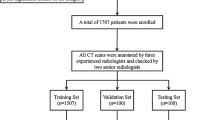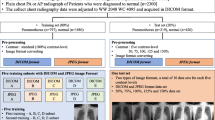Abstract
Purpose
Although a novel deep learning software was proposed using post-processed images obtained by the fusion between X-ray images of normal post-operative radiography and surgical sponge, the association of the retained surgical item detectability with human visual evaluation has not been sufficiently examined. In this study, we investigated the association of retained surgical item detectability between deep learning and human subjective evaluation.
Methods
A deep learning model was constructed from 2987 training images and 1298 validation images, which were obtained from post-processing of the image fusion between X-ray images of normal post-operative radiography and surgical sponge. Then, another 800 images were used, i.e., 400 with and 400 without surgical sponge. The detection characteristics of retained sponges between the model and a general observer with 10-year clinical experience were analyzed using the receiver operator characteristics.
Results
The following values from the deep learning model and observer were, respectively, derived: Cutoff values of probability were 0.37 and 0.45; areas under the curves were 0.87 and 0.76; sensitivity values were 85% and 61%; and specificity values were 73% and 92%.
Conclusion
For the detection of surgical sponges, we concluded that the deep learning model has higher sensitivity, while the human observer has higher specificity. These characteristics indicate that the deep learning system that is complementary to humans could support the clinical workflow in operation rooms for prevention of retained surgical items.





Similar content being viewed by others
Data availability
Not applicable.
References
Rajagopal A, Martin J (2002) Gossypiboma-“A Surgeon’s Legacy”: report of a case and review of the literature. Dis Colon Rectum 45:119–120. https://doi.org/10.1007/s10350-004-6124-1
Stawicki SP, Evans DC, Cipolla J, Seamon MJ, Lukaszczyk JJ, Prosciak MP, Torigian DA, Doraiswamy VA, Yazzie NP, Gunter OL Jr, Steinberg SM (2009) Retained surgical foreign bodies: a comprehensive review of risks and preventive strategies. Scand J Surg 98:8–17. https://doi.org/10.1177/145749690909800103
Gencosmanoglu R, Inceoglu R (2003) An unusual cause of small bowel obstruction: Gossypiboma—case report. BMC Surg 3:6. https://doi.org/10.1186/1471-2482-3-6
Jason RS, Chisolm A, Lubetsky HW (1979) Retained surgical sponge simulating a pancreatic mass. J Natl Med Assoc 71:501–503
Sun HS, Chen SL, Kuo CC, Wang S, Kao Y (2007) Gossypiboma—retained surgical sponge. J Chin Med Assoc 70:511–513. https://doi.org/10.1016/S1726-4901(08)70051-0
Regenbogen SE, Greenberg CC, Resch SC, Kollengode A, Cima RR, Zinner MJ, Gawande AA (2009) Prevention of retained surgical sponges: a decision-analytic model predicting relative cost-effectiveness. Surgery 145:527–535. https://doi.org/10.1016/j.surg.2009.01.011
Moffatt-Bruce SD, Cook CH, Steinberg SM, Stawicki SP (2014) Risk factors for retained surgical items: a meta-analysis and proposed risk stratification system. J Surg Res 190:429–436. https://doi.org/10.1016/j.jss.2014.05.044
Cima RR, Kollengode A, Garnatz J, Storsveen A, Weisbrod C, Deschamps C (2008) Incidence and characteristics of potential and actual retained foreign object events in surgical patients. J Am Coll Surg 207:80–87. https://doi.org/10.1016/j.jamcollsurg.2007.12.047
Mahran MA, Toeima E, Morris EP (2013) The recurring problem of retained swabs and instruments. Best Pract Res Clin Obstet Gynaecol 27:489–495. https://doi.org/10.1016/j.bpobgyn.2013.03.001
Yu D, Zhang K, Huang L, Zhao B, Zhang X, Guo X, Li M, Gu Z, Fu G, Hu M, Ping Y, Sheng Y, Liu Z, Hu X, Zhao R (2020) Detection of peripherally inserted central catheter (PICC) in chest X-ray images: a multi-task deep learning model. Comput Methods Programs Biomed 197:105674. https://doi.org/10.1016/j.cmpb.2020.105674
El Asnaoui K, Chawki Y, Idri A (2021) Automated methods for detection and classification pneumonia based on x-ray images using deep learning. Stud Big Data. Springer, Cham, pp 257–284. https://doi.org/10.1007/978-3-030-74575-2_14
Yamaguchi S, Soyama A, Ono S, Hamauzu S, Yamada M, Fukuda T, Hidaka M, Tsurumoto T, Uetani M, Eguchi S (2021) Novel computer-aided diagnosis software for the prevention of retained surgical items. J Am Coll Surg 233:686–696. https://doi.org/10.1016/j.jamcollsurg.2021.08.689
Sony Neural Network Console. https://dl.sony.com/ Accessed 4 Dec 2020
Wang X, Peng Y, Lu Z, Lu Z, Bagheri M, Summers RM (2017) ChestX-Ray8: Hospital-Scale Chest X-Ray Database and Benchmarks on Weakly- Supervised Classification and Localization of Common Thorax Diseases. In: Proceedings of the IEEE conference on computer vision and pattern recognition. IEEE CVPR 3462–3471. https://doi.org/10.1109/CVPR.2017.369
Vock P, Szucs-Farkas Z (2009) Dual energy subtraction: principles and clinical applications. Eur J Radiol 72:231–237. https://doi.org/10.1016/j.ejrad.2009.03.046
Kuhlman JE, Collins J, Brooks GN, Yandow DR, Broderick LS (2006) Dual-energy subtraction chest radiography: what to look for beyond calcified nodules. Radiographics 26:79–92. https://doi.org/10.1148/rg.261055034
Yang W, Chen Y, Liu Y, Zhong L, Qin G, Lu Z, Feng Q, Chen W (2017) Cascade of multi-scale convolutional neural networks for bone suppression of chest radiographs in gradient domain. Med Image Anal 35:421–433. https://doi.org/10.1016/j.media.2016.08.004
Zhou Z, Zhou L, Shen K (2020) Dilated conditional GAN for bone suppression in chest radiographs with enforced semantic features. Med Phys 47:6207–6215. https://doi.org/10.1002/mp.14371
Han L, Lyu Y, Peng C, Zhou SK (2022) GAN-based disentanglement learning for chest X-ray rib suppression. Med Image Anal 77:102369. https://doi.org/10.1016/j.media.2022.102369
Weprin S, Crocerossa F, Meyer D, Maddra K, Valancy D, Osardu R, Kang HS, Moore RH, Carbonara U, Kim F J, Autorino R (2021) Risk factors and preventive strategies for unintentionally retained surgical sharps: a systematic review. Patient Saf Surg 15(1):24. https://doi.org/10.1186/s13037-021-00297-3
Weprin SA, Meyer D, Li R, Carbonara U, Crocerossa F, Kim FJ, Autorino R, Speich JE, Klausner AP (2021) Incidence and OR team awareness of “near-miss” and retained surgical sharps: a national survey on United States operating rooms. Patient Saf Surg 15(1):14. https://doi.org/10.1186/s13037-021-00287-5
Acknowledgements
We thank Editage (www.editage.com) for the English language editing.
Funding
This work was supported by the Japanese Grant of The Clinical Research Promotion Foundation (2020).
Author information
Authors and Affiliations
Contributions
MK, HW, TS, TK, RM, HH were involved in study conception and design and analysis and interpretation of data; MK, HW, HA, TK, SB contributed to acquisition of data; MK, TS, TK, RM, HH were involved in drafting of manuscript; MK, HW, TK, SB, SU, KI contributed to critical revision.
Corresponding author
Ethics declarations
Conflict of interest
This study has a pending patent in Japan (2020–094615).
Ethics approval and consent to participate
This retrospective study was approved by the institutional review board in Kyushu University and conducted in accordance with the 1964 Declaration of Helsinki.
Consent for publication
The review board waived the requirement for written informed consent. The manuscript does not contain any individual person’s data in any form.
Additional information
Publisher's Note
Springer Nature remains neutral with regard to jurisdictional claims in published maps and institutional affiliations.
Rights and permissions
Springer Nature or its licensor (e.g. a society or other partner) holds exclusive rights to this article under a publishing agreement with the author(s) or other rightsholder(s); author self-archiving of the accepted manuscript version of this article is solely governed by the terms of such publishing agreement and applicable law.
About this article
Cite this article
Kawakubo, M., Waki, H., Shirasaka, T. et al. A deep learning model based on fusion images of chest radiography and X-ray sponge images supports human visual characteristics of retained surgical items detection. Int J CARS 18, 1459–1467 (2023). https://doi.org/10.1007/s11548-022-02816-8
Received:
Accepted:
Published:
Issue Date:
DOI: https://doi.org/10.1007/s11548-022-02816-8




